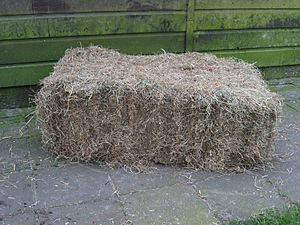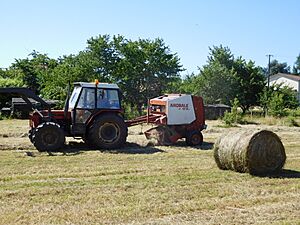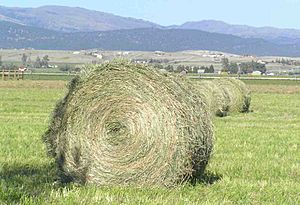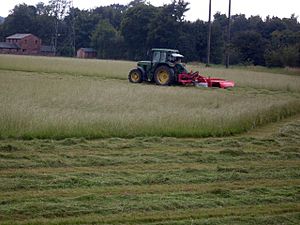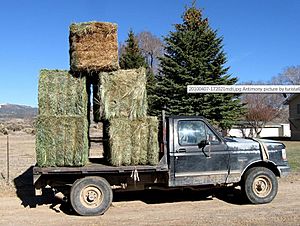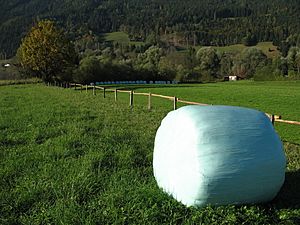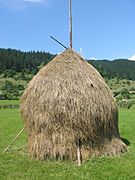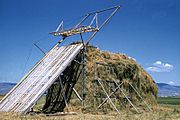Hay facts for kids
Hay is a type of food for animals. It is made from grass and other plants that have been cut, dried, and gathered. Once collected, hay can be stored in large piles called haystacks. It can also be pressed into tight blocks called bales. Bales can be round or shaped like a box (often called square bales).
Hay is mostly used to feed farm animals. Animals like horses, cattle, goats, donkeys, and rabbits all eat hay. Farmers give hay to their animals when there isn't enough fresh grass to graze on. This often happens in winter when grass doesn't grow, or during dry times when pastures are bare.
It's important to know that hay is different from straw. Hay is made from leafy grasses and plants like alfalfa. It is full of nutrients and good for feeding animals. Straw, however, comes from the stems of grain plants like wheat after the grain has been harvested. Straw isn't very nutritious. It's usually used as bedding to keep animals warm and dry.
Contents
What is Hay Made Of?
Hay is usually a mix of different grasses. Common types include ryegrass, timothy, brome, fescue, Bermuda grass, and orchard grass. The exact mix depends on where the hay is grown.
Sometimes, hay also includes legumes like alfalfa and clover. These plants are best cut before they fully bloom. Other wild plants, called forbs, might also be in the mix. However, some forbs can be harmful to certain animals, so farmers try to avoid them.
Sometimes, plants like oat, barley, and wheat are cut while still green and made into hay. But usually, these plants are used for straw. Straw is what's left after the grain is harvested. It's mainly used for animal bedding. While straw can be eaten, it has much less nutrition than hay.
Feeding Animals with Hay
Hay is a very important part of the diet for most grazing animals. It can provide almost all the food an animal needs. Animals usually eat hay when they can't graze on fresh grass in a pasture. This happens in winter or when there's a drought.
Most animals are fed hay twice a day, in the morning and evening. But animals that graze naturally eat small amounts of food all day long. Some animals, especially those raised for meat, might be given enough hay to eat whenever they want. Working animals, like horses used for riding, might get less hay so they don't get too heavy. The right amount and type of hay depends on the animal. Some animals also get extra food like grain or vitamins. But for most, hay or fresh grass should make up more than half of their diet.
Different animals digest hay in different ways. For example, cattle and sheep have a special four-chambered stomach. This allows them to break down older hay and handle changes in their diet better. Horses, however, have a single stomach and a cecum (a part of their large intestine). Their digestion is more sensitive to changes in food and to mold. This means horses need hay that is very consistent in type and quality.
Cattle can eat large amounts of hay at once. They then take a long time to digest it, often while resting. So, for cattle, the amount of hay is very important. They can even digest lower quality hay if they get enough of it. Sheep eat about two to four percent of their body weight in dry hay each day. They are very good at getting the most nutrition from their food.
Horses, unlike cattle, eat small amounts of food throughout the day. They can only use about 2.5% of their body weight in food over 24 hours.
Making and Transporting Hay
Making hay, also called "haymaking," involves several steps: cutting, drying, raking, processing, and storing. Hayfields don't need to be replanted every year like grain crops. But farmers often add fertilizer and sometimes plant new seeds every few years to get more hay.
The way hay is made has changed a lot over time, but the basic steps are the same. Tall grass and other plants are cut when they are just right. Then, they are left to dry, usually in the sun. After drying, the hay is raked into long, narrow piles called windrows. Finally, the dried hay is gathered, often pressed into bales, and stored in a haystack or a barn to keep it dry.
In spring and early summer, grass grows very fast. It has the most nutrients when its leaves are fully grown and its seeds or flowers are just starting to form. This is the best time to cut it. If hay is cut too early, it's hard to dry because it has too much water. It also won't produce as much hay per acre. But if it's cut too late, it becomes rougher and loses some of its nutrients. There's usually a two-week period when the grass is perfect for hay. For alfalfa hay, it's best to cut it when the plants are tall and starting to bloom.
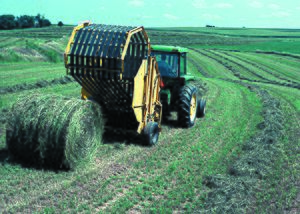
After cutting, hay can be raked into rows right away. Or, it can be left spread out in the field to dry first, then raked into rows. Drying can take several days. Farmers often use a hay rake or a tedder to turn the hay over. This helps it dry faster. If it rains, turning the hay can help it dry out again. But turning it too much can make the dry leaves fall off, which means less food for the animals.
Once the hay is cut, dried, and raked, it's usually gathered into bales or bundles. Then it's taken to a central place for storage. In some areas, hay is stacked loosely without being baled first.
Hay must be completely dry when it's baled and kept dry in storage. If hay is too wet when baled or gets wet later, it can catch fire on its own! Hay stored outside needs to be stacked so that water runs off it. Some stacks are shaped like a cone to shed water. Others use the bottom layers of hay to protect the rest. To keep hay completely dry outside, farmers might cover it with tarps. Many round bales are also partly wrapped in plastic during baling. Hay is also often stored inside sheds or barns. It's also important to keep hay away from any heat or flames, as dry hay and its dust can easily catch fire.
Modern Haymaking Machines
Today, many machines are used to make hay. Smaller farms might use a tractor to pull different tools for cutting and raking. Larger farms use special machines like a mower or a swather. These machines can cut the hay and arrange it into a windrow all at once. Balers, which press hay into bales, are usually pulled by a tractor. Bigger balers need more powerful tractors.
Machines that gather and bale hay in one step were first made around 1940. The first balers made small, rectangular bales that a person could lift, usually weighing about 70 to 100 pounds (30 to 45 kg). This size made it easy for people to load them onto trucks and stack them by hand. Later, machines were made to produce much larger bales, weighing up to 3000 pounds (1360 kg).
Some farmers also "condition" their hay. This means they treat it to make it dry faster, especially in humid places or if it rains. Often, a salt solution is sprayed on the hay (especially alfalfa) to help it dry. Conditioning can also mean using rollers inside a swather that squeeze the alfalfa to remove moisture.
Baling Hay
Small Bales
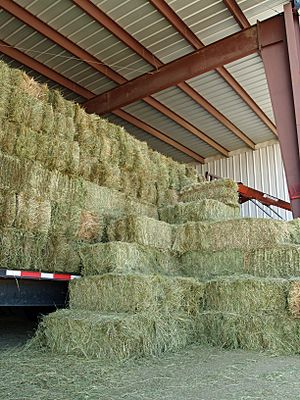
Small bales are still made today. Some farms even use equipment that is over 50 years old! Small bales are still popular because they are easy for one person to handle without machines.
Small square bales are often stacked in a criss-cross pattern, sometimes called a "rick" or "hayrick." Rain can wash away nutrients and cause mold. Small square bales are very likely to get wet, so they are often stored in a hayshed or covered with tarpaulins. If not, the top layers of the stack might rot.
There's also a risk that hay bales might be moldy or contain dead animals. These can create poisons that are dangerous for animals like horses. If this happens, the whole bale is usually thrown away. This is another reason why some people still prefer small bales, as it's easier to spot and remove a bad bale.
Large Bales
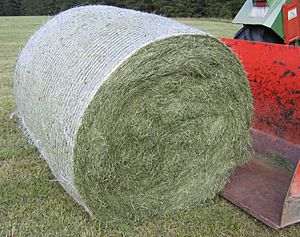
Farmers who need to make a lot of hay often choose balers that make much larger bales. This helps protect more hay from the weather. Large bales come in two types: round and square. Large square bales can weigh up to 1000 kg (2200 lb). They are easy to stack and transport on trucks. Large round bales usually weigh 300 to 400 kg (660 to 880 lb). They are more resistant to moisture and pack the hay more tightly, especially in the middle. Round bales are also easy to feed to animals using machines.
Because of their shape, many farmers in dry areas can leave large bales outside until they are eaten. In wet places or where there's a lot of snow, farmers can stack round bales under a shed or tarp. They can also use a light plastic wrap that partly covers the bales left outside. This wrap keeps out moisture but leaves the ends open so the hay can "breathe" and not ferment. However, storing round bales under a shed makes them last longer and prevents more hay from rotting.
Haylage
For animals that eat silage, a special machine called a bale wrapper can completely seal a round bale in plastic. This starts a process called fermentation. This method is used by farmers who don't have a silo or need to transport silage. In very damp climates, it's a good way to store hay without drying it completely. If done right, the natural fermentation stops mold and rot. Round bale silage is sometimes called "haylage." It's more common in Europe than in the United States or Australia. But hay stored this way must stay completely sealed. Any holes or tears can stop the fermentation and cause the hay to spoil.
Haystacks
Haystacks are piles of harvested hay. They are built in many different ways, depending on the area, climate, and whether the hay is baled or loose. Hay needs to be protected from the weather. It's best stored inside buildings, but haystacks are also built in open fields. Sometimes, a fence is built around a haystack to stop animals from eating it. Other times, animals are allowed to eat directly from a haystack in the field during winter.
Haystacks are also sometimes called haycocks, stooks, shocks, or ricks.
Loose Hay Stacking
Loose haystacks are built to keep moisture out and help the hay dry. In some places, this is done by making stacks with a cone shape or a ridged top. The outside of the stack might look gray from the weather, but the hay inside still smells fresh and has a faded green color. Loose haystacks can be covered with thatch or kept inside a protective structure. One such structure is a movable roof held up by four posts, historically called a Dutch roof or hay barrack. Haystacks can also be built on a base of wood or brush to reduce spoilage from the ground. In other areas, loose hay is stacked around a central pole, a tree, or within an area of three or four poles to make the stack more stable.
One way of stacking loose hay in the British Isles is to first make smaller piles called foot cocks or haycocks. This helps the hay dry at the beginning. These small piles are sometimes built on platforms or tripods made of three poles. This keeps the hay off the ground and lets air flow through the middle, helping it dry better. The shape makes dew and rain roll off, allowing the hay inside to cure. People moving hay might use hayforks or pitchforks to build these piles. Building very tall haystacks is sometimes helped by a ramp, from simple poles to a large machine called a beaverslide.
- Loose hay stacks and hayracks
Images for kids
See also
 In Spanish: Heno para niños
In Spanish: Heno para niños


